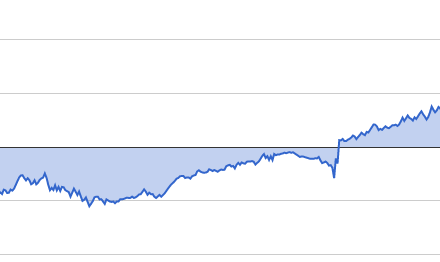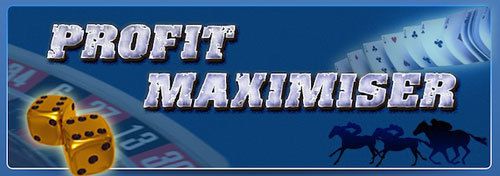Part One: The Selection Process
Part of the Betfair Exchange Trading Profit Series
In this series of four articles I am going to reveal the secrets of my under 2.5 goal success. At the moment I am trading at around a 90-95% strike rate in this market!
If you’re new to goal spread betting and are wondering why there’s a half goal, it’s just so you can have 2 outcomes rather than 3 under or over instead of less than 3 goals, exactly 3 goals, more than 3 goals.
By the time you have read all four articles you will have the tools to go off and start making money in this market. So let’s begin by looking at the best type of teams to choose when considering trading in this market.
Late Conceding Away Team
Some teams set out their stall from the off and some get super defensive away from home after a couple of away day thrashings, whatever the reason, these teams tend to set up to not lose, hence they’ll get a lot of low scoring draws on their travels.
Now obviously you don’t want a team who is winning every away game 0-4 unless you want to go for over 2.5, but if like me you’re an unders man, then the combination of tight defence and a couldn’t-hit-a-cow’s-arse-with-a-banjo strike force is a team that will end up making you a lot of money.
One thing to remember is that the Late Conceding Away Team is not to be confused with the Defensive Away Team, just because they concede late doesn’t mean that their games won’t end up over 2.5 goals, it just means that we can profit from them before any goals go in.
Let’s take a look at this in practice, looking at the 2014-2015 English Championship season, let’s start with Sheffield Wednesday.
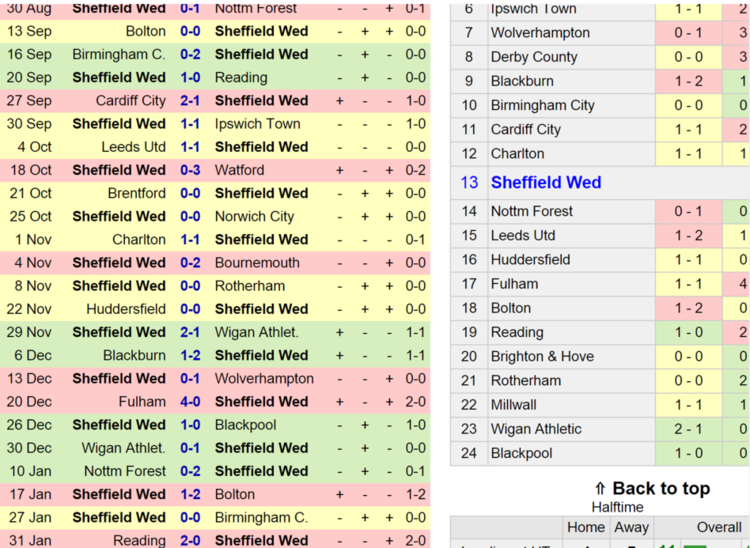
Wednesday scored over 2.5 goals in 43% of their away games, the average being 50%, now this in itself is not particularly impressive. However for much of the season they were below 40% towards the end they ended up scoring and conceding more away goals. But they kept one interesting trait and that was, their defensive attitude meant they conceded very few goals before 35 minutes, which if you are employing the liability reduction technique, then this is music to your ears and money in your bank.
If we look below at Millwall v Sheff Wed we can see that Wednesday won 1-3, which we may have expected as Millwall were above average for over 2.5, especially at that point. However we can see that because of Wednesday’s perpensity for not conceding many in the first half of games, means that we could have traded that game and been zeroed on our liability before half time.
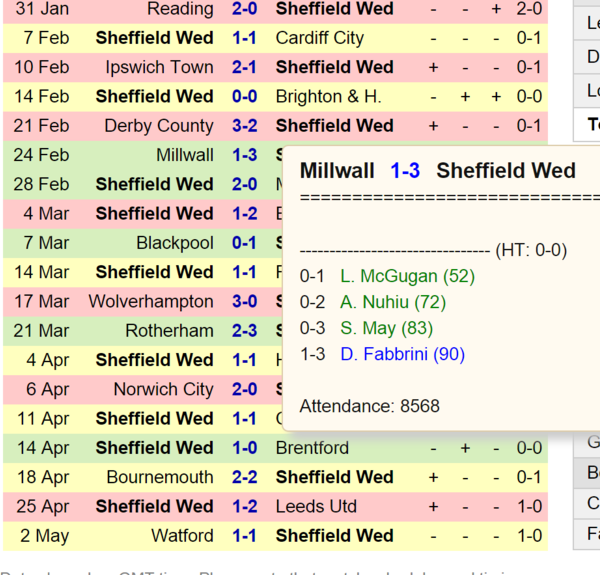
Then we could have either greened up both ways in the first five minutes of the 2nd half, or we could have waited till around 65-70 minutes to get a decent green if we had missed it before the 52nd minute first goal.
Betfair Trading Advice:
Use teams like these sparingly as the phenomena can come and go, they are best used against teams that are higher than them in the league as their trait of late scoring will be magnified against quality opponents.
The Recently Thrashed Team
Trading the recently thrashed team should be part of your general strategy for playing the under 2.5 goal market. It is a phenomena I first became consciously aware of in the 2002 World Cup, when Germany thrashed Saudi Arabia 8-0 in their first game.
Back then I used instinct to predict that Saudi’s next game would only see them lose their next game by no more than a goal to nil, I reasoned that the last thing they wanted to do was to be humiliated in every match they played, maybe even setting the worst record ever for goals conceded in a World Cup.
Saudi Arabia did indeed lose their next game 1-0 and subsequently won me some money for my correct score prediction. So I started to investigate whether this was always the case, that a team that had just been thrashed and by thrashed I mean a 5-0 minimum, would always concede under 2 goals in their next game.
Needless to say I found this to be the case; look at Birmingham’s game against Bournemouth above. As you can see they were thumped 0-8 at home by the eventual champions. Look at their next game they were up against Millwall who were flying high , unbeaten in 4 games winning 2 back to back, they had scored 8 goals and conceded 6.
Those are the kind of recent home stats that are to be avoided if you’re looking to trade under 2.5 goals. However they were of course about to play a team that had just shipped 8 goals, so their priority and in fact any team’s priority after being thrashed is DON’T CONCEDE A GOAL!
You will have noticed that I underlined Reading’s thrashing by Birmingham on the 13th of December. Well look below at the result of their game after.
Watford by the way were flying at this point, they scored 7 goals in their previous 2 and 4 in their subsequent 2 games. Yet they could only beat a recently thrashed Reading 0-1
Betfair Trading Advice:
Always trade under 2.5 goals on a team that has just been thrashed, doubly so if their next game is away. There are big profits to be made because the market will be reacting to their last game instead of their current one.
However bear in mind that it is not an exact science and there have been instances of teams getting thumped twice in a row. If a goal is scored in the first 5 minutes of their next game and you are not watching the game, trade out immediately for a loss.
Defensive Home Team
The advantage of trading defensive home teams is obvious, they tend not to concede, the disadvantage is they could be good scorers. However by and large they are good teams to trade on.
Let’s look at a good defensive home team in Chelsea, The Blues won the 2014/15 English Premier League title at a canter, losing only 2 games and only failing to score twice, so you would think that they weren’t that great for under 2.5.
This would have been true for Chelsea away as they scored 8% over the average for over 2.5 goals away, however at home their games only resulted in over 2.5 goals 32% of the time. In other words, there were 13 games out of 19 that you could have won money on under 2.5 goals. To put that in perspective, that was the joint lowest last season, the other team was Burnley who finished 2nd from bottom.
Betfair Trading Advice:
Trading on teams like Chelsea who are good defensively at home but also good scorers is difficult if you are using a reduced liability strategy as they can score at any time and waiting for the odds to fall in a game which has seen 2 goals in the first 20 minutes, will cause you a lot of stress.
Use teams like this when they are playing other teams very close to them in skill, so in Chelsea’s case it would have been about backing them when they were playing a top 6 side at home. Or a relegation threatened side near the end of the season.
This type of team suits the leave it method and can be very lucrative as the market rarely reacts to their low scoring tendencies.
Defensive Away Team
I like defensive away teams because they don’t mind drawing and they don’t have the same pressure on them to score from the crowd like they would at home. In fact a good combination can be a defensive away team that is also struggling at home, but we’ll talk about that later when we look at killer combos.
If we look here at the 2 charts in the English football League One for goals conceded and under 2.5 goals away from home, we can see that backing a defensive home team isn’t an exact science and more than ever we can’t rely on this stat alone. All we can say is that a defensive away team is a potentially good early indicator that any one of their given games may end up under 2.5 goals.
When you are using the goals scored/conceded chart looking for a defensive away team you must consider the left as well as the right. We can see Walsall as the stand out team here as they achieved 9 clean sheets in the season, but also failed to score on 9 occasions. Of course there will be times when we are focussing more on what they concede than score, for instance if Bristol City were playing a particularly defence home side like Rochdale or Preston.
Don’t use a teams away defence as your only marker for entering an under 2.5 goals trade on them. Rather use it as a good early indicator which should make up a number of criteria for making the trade.
If they are defensive but high scorers this makes them riskier, but it also means that the odds on their matches with defensive home teams could be higher than they should, thus delivering bags of value and an opportunity for an early cash out.
Summary of part 1
OK that’s a break down of criteria I use when choosing teams to trade in the under 2.5 goals market in English football. Of course these criteria can be used in any country, but I personally feel that it’s the best market for me because it’s the one I know.
In the next article in the series I’ll be looking at more types of teams that can make us a lot of money when trading in the under 2.5 goals market.
The Selection Process 2
This is part 2 of 4 of the BTT Under 2.5 goal success selection process, in this article you will find out more about what teams make for under 2.5 goal gold on the betfair exchange and also who to avoid.
Low Scoring Home Team
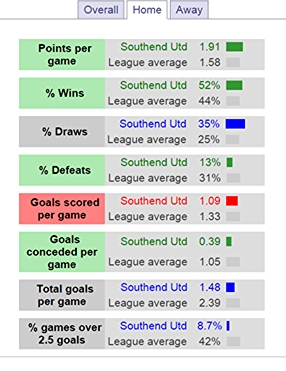
In a sense this should have been right at the top of Part 1, because a low scoring home team is probably the bread and butter of the under 2.5 goal trader, just like my beloved Southend United. Southend for the majority of the season had 0% of their games finishing above 2.5 goals a dream scenario for any sports trader, finding a team that consistently does something.
The great thing about Southend was that they were just above average for over 2.5 goals away from home, this often meant that their odds for under 2.5 at home were artificially high because of what had happened to them in their previous game.
By the way they’re my beloved because of the amount of money their stingy defence and profligate strikers made me.
Betfair Trading Advice:
Low scoring home teams should be part of your staple diet when it comes to trading in the under 2.5 market. In general football teams tend to concede less goals at home than they do away, so when you combine this with low scoring it tends to pay dividends.
It’s hard to put a percentage value on how many of your trades should involve low scoring home teams but I would say it should definitely be 50% or more. In fact you can use them to gauge how conservative your strategy is. If you are trading mainly these type of teams then you are being conservative which isn’t necessarily a bad thing. But if you are looking for ways to be a bit riskier in this market, thus accessing potentially higher returns, then cut down on the amount of low scoring home teams you trade in as these will always have the lowest odds.
Low Scoring Away Teams
The reason I like low scoring away teams is because generally, away goals are harder to come by than home goals. Wretched form can strike a team at any time home or away or both at the same time. But a lack of goals away from home is harder to rectify than home goals, for one thing you haven’t got home referee bias, fuelled by the home crowd to help you out.
So a team who is scoring few or even better no away goals from the start of the season will more likely keep that form than any other. Even when that team is doing well away from home it will mainly be 1-0 wins or plucky fought 0-0 or 1-1 draws.
Betfair Trading Advice
Make sure you keep low scoring away teams in your portfolio, they can be easy to miss, especially if they go on a run of being beaten with high scores to nil. or if they are scoring lots of goals at home. But ignore them at your peril as they can often be involved in games whereby the under 2.5 odds are 1.9 and higher.
Current Form
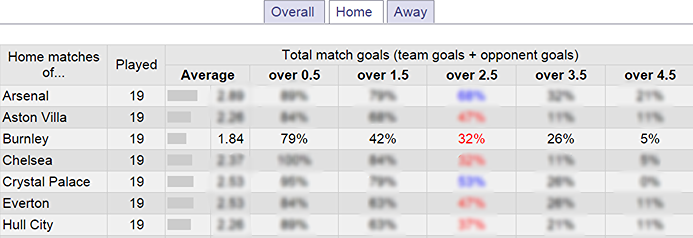
Because it’s not humanly possible to track every single team all the time we use current form to test a team’s season average.
So in the example above we are looking at the under 2.5 goal stats for Burnley at home and below West Brom away. We can see that 32% (rounded up) of Burnley’s home games ended with 3 goals or more and 37% of West Broms away games.
Let’s imagine that we see that on game 24 of the season Burnley are at home to West Brom, we’ve noticed earlier in the season that this could be a ‘perfect storm’ game of low scoring/low conceding at home meet low scoring/low conceding away.
If we were to use the above stats which at the time were even better for our under 2.5 trade, then we would see it as a game we would be able to get quite a lot from. But as we can see from below, current form tell’s it’s own story.
As you can see that in the 2 home games for Burnley before the West Brom game; both ended over 2.5 goals with the Palace game ending up over 4.5 goals. Add to that the two high scoring away games before that and the picture starts to look bleak. One other indicator that current form is not in line with overall form is that Burnley have conceded in each of the previous 5 games and only failed to score once.
The final nail in the coffin for an under 2.5 trade on the West Brom game is if you look to the right you can see that all of their half time scores were either over or on the brink of being over 2.5 goals. Clearly if we were coming in to trade on them on the 8th of Feb then we would rightly deduce that their form was not matching their season performance so far and this is either a turning point or a blip, but either way they are not good for trading in the unders market and won’t be for at least a few more weeks, once we see if they settle back to their season ‘norm’.
We can look at the away stats, although in this situation I would really only be checking to see if West Brom were absolutely thrashed the week before, otherwise those home statistics for Burnley would be enough to put me off any kind of under trade.
So we can see that West Brom’s stats are no where near as conclusive as they are for Burnley and in fact you may have made a case for their up coming game with Burnley to be under 2.5. Their last 3 away games have been under and 2 of the half time scores have been 0-0.
However there are subtle clues and I’m not talking about the 0-3 loss to Spurs, but more the fact that home or away they are not scoring and have combined it with the lethal combination of conceding in practically every game.
Betfair Trading Advice
Always look at current from, the last 3-5 games overall and then look at recent home or away games, obviously relating to whether that team’s next game is home or away; remember sometimes you may find that away form is shocking and home is good, so it’s always best to bear that in mind when checking form.
Be careful of the 2s! If you see that 2 goals have been conceded and scored more than 50% of the last 3 games of both teams that you are going to trade on, stay away as this usually indicates an over 2.5
Special Circumstances
I’ve left the weakest indicator till last, it is weak because it relies a lot on human reaction and human nature, but as always with riskier trades, it can lead to greater rewards.
An example of a special circumstance would be a cup match, especially if you have a solid team playing a good middle table type team who is a league above. So you may get a team that are scoring and letting in goals left right and centre. They get drawn in one of the cups with another team that is also seeing the goals fly in, meaning the odds will not represent how tight the game is likely to be.
In the later rounds of the cup so at least the quarter finals. It is these conditions that can lead to the first half of the match being very tight, in fact the closer to the final you get the tighter it will be. To the point that a lot of cup finals in England and the major European ones at half time are often either 0-0 or 1-0 home or away.
This obviously gives the under 2.5 goal trader an excellent opportunity, for the obvious reason that two such high scoring teams with leaky defences will have pretty high odds of their match finishing at under 2.5 goals.
Betfair Trading Advice
This is the weakest of all the indicators, however that doesn’t mean it is about to be ignored, especially when trading FA Cup or Champions’ League semi finals and finals. Look to trade out by the end of the first half as 2-1 is a popular Champions League final result and cup games often liven up in the second half.
Summary of part 2
OK that’s it for the selection process, over the last two articles we have looked at the best kind of teams to look for when we want to trade in the under 2.5 goal market in English football. Next we are going to look at how to pair these teams up so that we can get the highest possible yield from our trades.
We will look at the statistical likelihoods of certain matches finishing either under or over 2.5 goals and finally in the last article we’ll look at our in-game strategy and making sure that even if a game we pick finishes over that if there is a chance we still make money.
Under 2.5 Secrets Pt. 3 – Strong & Weak Indicators
In the two previous articles we’ve looked at the types of team to trade on in the under 2.5 goals market on the Betfair Exchange. Now lets look at the killer combinations, basically two teams that have all the signs of being involved in a low scoring game.
In this section we may mention some types of team that we haven’t mentioned before, simply because these teams only work as a combination.
We will also look at the warning signs before and crucially, while we are trading, we will find out if we can predict when things are about to go wrong.
Ultra Defensive/Low Scoring Home v Recently Thrashed Team
I like these games for three main reasons, first, as I’ve mentioned before recently thrashed teams tend to have 1 or less goals in their next match; but with this kind of match up it is as nailed on as you will ever get in this market.
Secondly they often stay 0-0 for long periods, giving me plenty of time to make my trade. And lastly a recently thrashed or at least well beaten team, will artificially inflate the odds for under 2.5 meaning that there’s often a chance to zero liability in the first 10- 15 minutes of the match.
Betfair Trading Advice
Watch out for these games like a hawk, this combination when it is succesful will make 25-50% more than a standard defensive home v defensive away. They take a braver heart as it can be difficult to put money on a team that is getting beaten easily at home but doing well away. Just make sure you do your research and stick to your pre match strategies and you’ll enjoy these rare gems.
Low Percentage Home v Low Percentage Away
Ultimately the types of team that I’ve mentioned thus far, will mean in most cases both teams will have a low percentage of games that finish with 3 goals or more.
So clearly that is the template for roughly 80-90% of your under 2.5 trades, current form comes into play and just because a team has a low percentage of games ending with over 2.5 goals and is playing another low percentage team doesn’t mean you should just blindly trade on them.
One thing to remember about the over/under percentage statistics is they don’t tend to make much sense until the team has had at least 6 games each at home and away.
So it is a case of the longer the season goes on the more you can trust those percentages, which is probably why at the beginning of last season I had about a 65-75% strike rate and that had risen to about 90% with two thirds of the season gone and 100% in the last quarter.
So midway through the season I start to pay attention to the percentage charts in a way that I am not at the beginning of the season.
So that for me is the start of a great match up and that is a team who has an average which is less than 20% of the norm. So if the norm for home games over 2.5 in the league is 50% then I will ideally be trading on a home team with 39% or less games over 2.5 goals at home.
If the away norm is 45% then I will not trade on any team above 35% as 20% of 45 is 9% 45-9 = 36 therefore 35% is my upper limit for away teams under 2.5 goals.
Betfair Trading Advice
This is a fluid statistic which changes as the season wears on and I will break the rule now and again, especially near the start of the season, but it’s a great guideline to go with once the season is at least a third of the way through.
Use this more and more as the season wears on, but always check against current form.
Low Scoring Defensive Home Team v Low Scoring Defensive Away Team
This is the perfect storm that you are seeking when looking to trade under 2.5 goals it will form the main part of your trading as it is the most statistically likely game to end up under 2.5 goals. These games are often draws or stay 0-0 for a long time, enabling you to make money way before the final whistle.
Betfair Trading Advice
The odds on these types of team will typically range between 1.55 and 1.75, the odds will depend on where the two teams are in relation to each other in the table and of course current form.
The best way to use these teams is to watch out for when they come off the back of heavy defeats or victories. So for example if a team like Sheffield Wednesday who were the side with the fewest games at home over 2.5 goals in the 2014/15 English Championship season. If they had just had heavy away defeats or victories then the odds for their next home game for under 2.5 will be that bit higher.
Recently thrashed team v Low Scoring Away Team
As I said earlier backing a recently thrashed team to get under 2.5 goals in their next match is not an exact science but it does seem to happen more often than not. If the game in question happens to be against a low scoring away team, then the chance is increased significantly.
Birmingham were trounced 0-8 in front of their own fans, in what must have been a truly humiliating experience for all involved, from fans to player, to mascot. They faced Wolves who were a high scoring home team, yet the game finished 0-0.
As I’ve mentioned before a recently thrashed team are great to trade on wherever they’re playing next, like Reading who where thrashed away by Birmingham 6-1 and only lost 0-1 at home to Watford the next game. However the percentage chance of it being under 2.5 if their next game is at home, is just that bit better.
Betfair Trading Advice
Take each one of these games on its own merits, try and analyse why the team got thrashed and look at who they’re playing next. The size of the thrashing has a bearing, being beaten 4-2 is nowhere near as bad as 5-1 or 8-0, those kind of humiliating thrashings tend to bring out the best defensive qualities of a team in their next game.
But remember it’s not unheard of for a team to be thrashed two or even three games in a row
In Game Contra indicators
We’ve talked a lot about what teams we should be looking at in this market, these are our pre game indicators, of course any pre game indicators are extremely important because it is on these that we place our initial bets on before the event has kicked off.
However there are a few in-game contra indicators that we should be wary of, in other words things that suggest that our trade is going wrong and that the game will finish above 2.5 goals, sometimes these contra indicators are strong, sometimes weak, it’s up to you to spot the difference
Goals
Time Of First Goal
The time of the first goal is a good general indicator as to whether the match in question is going to end up with more or less than 2.5 goals. If the goal is scored within the first 18 minutes of an English League match, then the odds are quite high that the game will finish at 2-1/3-0 or greater.
“So should I trade out if a goal goes in before 18 minutes?”
In general yes, the minute an early goal has gone in then you need to adjust your pre-match expectations from somewhere between nice win and cut your losses.
However it does depend on who’s playing and who has scored.
Let’s take Burnley in the Premier League for example, in seven games last season they conceded in the first 18 minutes and on six out of the seven the games finished up with more than 2.5 goals. Which by the way is a slightly higher percentage than the average.
Burnley finished the season second from bottom of the league and were subsequently relegated, but for a brief spell in November and Early December they looked like they were down from the first kick of the season.
A goal in the 12th minute will result in most games finishing with 3 goals or more
So when trading Burnley games last season, by and large you would have expected a draw or a loss from them, so any early goals should have had you running for the Betfair hills.
However let’s look at my favourite team in the 2014/15 English League 2 season; Southend United. Only 8.7% of their home games finished above 2.5 goals; that’s just two games!! That statistic was 0% until the 14th of February, that’s just over six glorious months without a single home game finishing over 2.5 goals. A truly astounding statistic, on the flip side away from home they had a slightly above average 43% over 2.5 goals.
So with an ultra defensive/low scoring home team like Southend I would leave it till the second goal before I panicked If we look at how many times they conceded a home goal at 18 minutes or before, we see it happened 4 times but only one of those games ended up over 2.5.
That game was against Wycombe who had been involved in lots of high scoring games at the time, so if you had been following the rule of 2s you would have stayed away from that game. The rule of 2s is simply if a team’s last 3-5 games has had a high amount of one team or both scoring 2 goals in the game, especially lots of 2-0s, stay away from them.
Betfair Trading Advice:
If you are blind trading a game, then the first 18 minutes is your big danger zone as an objective truth the majority of games will finish over 2.5 goals if the first goal is within 18 minutes. However it is best to assess beforehand how safe you think the trade is and what type of teams are playing.
If a goal goes in for the ultra defensive home team then the chances are they will get even more defensive and concentrate on not conceding rather than consolidating with another goal; though this does not account for an away team going all gung-ho and leaving gaps at the back.
As a rule away goals before 18 minutes are more dangerous than home ones, but that is by no means an absolute and each situation should be taken on its own merits.
Cards Shown
Yellow Cards
It doesn’t take a football stats genius to know that punitive cards shown in a game can effect the outcome of the game, but the question is; how do yellow or red cards effect whether it will be over 2.5 goals or not?
If I’m blind trading a match in the under 2.5 goals market, blind trading by the way accounts for most of my trading in this market. Then yellow cards in the first half as long as they are evenly distributed amongst both teams won’t bother me much.
Possible warning signs with yellow cards are when one team get’s a flurry of 3 or 4 yellow cards in a 5-10 minute period. I may do a quick cross reference and check to see if they are all defenders, if they are I’ll reduce my liability as goals often come after yellow card flurries.
Yellow card flurries in the first half at 0-0 will not worry me as much as they will in the second half at 1-0 whether it’s for the team leading or the one chasing. Goals can come very quickly after these flurries and if I can green up immediately I will, if not I get my liability as close to zero as possible.
Red Cards
A late, first half, red card for a defensive home team at 0-0 is nowhere near as bad as a late, second half red card for a defensive away team.
In the first instance a red card usually signifies a mistake, in the second, that the team are under pressure. Therefore in the second instance, I’m outta there quicker than you can say Raheem Sterling.
Betfair Trading Advice:
Cards are one of the weak indicators of the market and a red card to a team that has been attacking can actually help your under 2.5 trade.
Yellow card flurries are even weaker indicators but it is best to keep them in mind when you are at or near 100% liability on your trade.
Summary of part 3
We have looked at the best pairings for the perfect under 2.5 goals trade, in the final article we will look at the actual in-game methods that we can employ in order to maximise our profits when trading in this market.
Under 2.5 Secrets Pt 4. – The Method
In this series we’ve been looking at how to trade for profit in the under 2.5 goal market in English football on the Betfair Exchange.
We’ve talked so far about the best types of teams to trade on, the best combinations of teams and indicators and contra-indicators for games ending under and over 2.5 goals and we’ve talked about using current form to predict when and how many goals there will be in a selected football match.
Now in the final article in the series it’s time to look at the overall and the specific trading strategies we can use when trading on Betfair in this market.
The Bump And Ride
Let’s take a look at a technique that I like to call the Bump & Ride strategy.
This strategy can be used as a specific strategy or as your general trading strategy, I would say it is more dangerous as a general trading strategy as you’re increasing the chances of it going wrong exponentially.
An optimist might say you’re increasing the chances of it going right exponentially; however because you don’t have an endless pit of money, you have to pay more attention to the downside than the up.
So what is Bump & Ride?
Quite simply the Bump & Ride technique is where you put more money on under 2.5 after the first goal, so that you can get even bigger odds. If the goal is in the first 20 minutes you may get odds as big as 3.8 or higher.
If your research is sound and the game carries on to be a turgid affair with few goalmouth opportunities, the odds will fall quicker than Petr Cech’s popularity at Chelsea and you will be in line for a nice big pay day.
Using B&R for a specific strategy is not bad, I have employed it myself a couple of times; though usually in the games that I choose the goal isn’t early enough to make it worth it; once a goal goes in after about 40 mins the odds will jump up to around the starting odds, which totally defeat’s the point.
You can use Bump & Ride in a few different ways, they are;
Early first half – home goals
If the home team is a big favourite then an early first half goal will see the odds rocket to 4 and beyond. In my view if you employ this type of trading on a regular basis then perhaps you have an even smaller aversion to risk than John Terry’s dad.
Early first half – away goals
If the away team is the underdog you will see those sky high odds after an early away goal, as before it is only the thrill seekers amongst you who will try and employ this as a general trading strategy for every under 2.5 goal trade you do.
Early first half – all goals
This being a combination of the first two means you regard risk as a close personal friend if you employ this as a general strategy, but as with the first two there could be reasons that lead you to believe there will be an early goal in a specific match and no or just one more late one.
Betfair Trading Advice:
In my opinion Bump & Ride is too dangerous to use as a general trading strategy especially in the first half to three quarters of the season. Use it more as a specific strategy, if you see a team has a tendency to score or concede early goals and all the other conditions are right for that match to end up under 2.5, then devise a strategy whereby you put more money on if there is an early goal for or against that team.
Cup finals can be good opportunities for the Bump & Ride strategy as early goals can often be the only ones scored.
Second goals are not to be traded on in any circumstance you are putting yourself in an unacceptable risk scenario by backing into the second goal if you haven’t greened up by then; hence I don’t believe in even giving it as a valid strategy for this market, though I’m sure plenty would disagree.
Boom Or Bust
Boom Or Bust is where before your trade you choose an amount of money that you want from your initial projected profits and a time that you’re prepared to wait for that and you simply place the trade and leave it.
It is the tactic that I first employed in this market, the reasoning was somewhere along the lines of;
Put initial £40 stake @1.8 – target 50% of virtual profit (£18 minus comms) – time target 57 minutes at 0-0 – 75 mins at 1-0
The problem with this strategy is that I was often faced with sticking to the other component of general trading strategy which was trading out after 2 goals regardless of position or ignoring it and putting myself in unacceptable risk scenarios.
I found myself trading out of winning trades because of the times of the goals, which eventually led me to the right strategy.
Betfair Trading Advice:
Boom Or Bust trading is really just normal betting in disguise and is what most people do when moving from traditional bookmakers over to the Betfair or Betdaq exchange. Punters who still make bets with high street and online bookies will also tend to favour this type of boom or bust trading.
It’s rewards can be high, but it’s penalties are often higher, though that does not mean it should be dismissed altogether. Use Boom or Bust trading as a specific trading strategy, maybe there is a certain game, involving certain teams that you just know you can leave for long periods of time. As a blanket, all encompassing general strategy it doesn’t work, so be wary that you don’t start applying this to every trade you do.
Periodical Reduced Liability
As you can probably guess or if you have ever watched my #BTTLive feed on Twitter, then you’ll immediately understand what I’m talking about. But for those of you that don’t Periodical Reduced Liability or PRL is whereby your liability is reduced at prearranged times and/or odds targets.
So for any trade which starts at between 1.68 and 1.9 I will reduce my liability by half once the odds fall to between 1.42 and 1.51 or 20 minutes whichever comes first.
Then my next point is 34 minutes or 1.27-1.35 whichever comes first, at that point I will zero my liability.
Then I am looking to get to green up for half the value of my original stake or 54 minutes whichever comes first.
So that’s PRL when it goes right, I have halved my liability by 20 minutes, zeroed by 34 minutes and out of there by 54.
Right all well and good, but what if it goes wrong? What then?
Glad you asked!
For an under 2.5 goal trade to go wrong you need an early goal for either team, so let’s look at what to do if goals go in.
1-10 Goal! – Trade out immediately for around a 30%-55% loss – Exception – If your pre game research indicates that the home team is ultra defensive/low scoring and the away team is low scoring then I will risk staying in there, still aiming to reduce my liability, however because of the price rise, I may have to accept that I’m going to make less on this particular trade.
11-18 Goal! – Trade out immediately for around 20-40% loss – Exceptions (as before)
19-33 Goal! This should be after the liability is halved so we are in a much better place, the closer to 33 minutes the less action I will take as a goal will only see you down for a 0-5% loss – Option to reduce liability further but no need to panic.
Safe Zone
34-HT A goal scored after your liability is zeroed will not affect your liability as that is now zero. Though I will adjust from 54 minutes for a final cashout, to 58-64 or 45% of the value of the initial profit projection.
46-54 Goal! A goal here will not affect liability and there will still be room for manoeuvre – I will tend to balance in favour of unders at a ratio of 75% -25% so If it was saying after a goal that my cashout was £20 then I would adjust it so that I had £15 green on under 2.5 and £5 green on over 2.5 (This covers me if there’s a second goal and stops me from experiencing a Zero Point Blank scenario) I would then leave it till 75 mins as my overall policy is that unless it is a specialised reason that I should not be in any football trade past 75 minutes.
Strategy Implementation
So let’s look at the process for applying the overall strategy into a more specific one; as I’ve mentioned previously the data for under 2.5 goals get’s more reliable as the season wears on. I also have said in previously that I don’t believe you should trade seriously before 10 games.
So I’m going to break this down into 4 parts of 9 games each and I’m basing this on the lower leagues of English football as they have more games and kick off before the Premier League.
Games 11-20
OK the season is well under way and each team will have 5 homes and 5 aways, there maybe the odd one with 6 homes or 6 aways and 4 of the other but by and large it will be five and five.
The first thing I will do is go to my Trading Notebook and see if there are any teams that I’ve earmarked as potential low scorers and/or conceders. I will also see if there are any teams that are emerging as better away than home. Or just any stand out statistics that indicate I should be backing under 2.5 goals with that particular team.
After this I will look at the under/over chart for the three English divisions below the Premier League and again I’m looking for a team that has finished at least 3 out of 5 of their home or away games with under 2.5 goals. Once I have spotted my potential teams for that day, I will look at the fixture list and find out who is playing.
If I’m lucky one of my identified home teams will be playing one of my identified away teams, if not I refer to the previous chart and try and pick out the lowest scoring ones and check who they are playing.
If the low scoring teams are playing the high scoring teams then I won’t trade for that afternoon, if I see they are playing low scoring or high defensive teams, then I will trade.
However the big factors with my research this early on in the season, are current form and team news as these are the best indicators to go with at this stage.
Games 21-30
Now we’re heating up at the beginning of this period, everyone has played on average 10 games both home and away. We can now start paying attention to the under/over percentage stats and we can be sure that they’ll be much stronger indicators than they were at the start of the season.
I’ll still probably only make one trade per game day at the start of this period, but I will probably try and take it to 2 by about game 30.
So checking out the lowest percentage of teams home and away to finish their games above 2.5 goals is the first port of call.
Then the trading notebook, to remind us what teams we have earmarked as potential or definite trade material. This is also the point of the season where I can start categorising teams into my criteria groups such as Defensive Home Team, Low Scoring Away Team etcetera.
Games 31-40
This is the real meat of the season and as long as current form matches up to the over/under percentage stats I will be risking between 3-5 times more money than I was at the beginning of the season. I am looking for at least 2 games a week I can trade on, but on those perfect storm weeks when all the right teams are meeting each other, I will make 4 trades.
This is the time of the season I may even employ Bump & Ride tactics for specific games; namely whereby defensive home teams are scoring early consistent goals but not adding to their tally and rarely conceding and low scoring away sides that also concede a goal early but also score late.
I may even employ soom Boom Or Bust tactics for certain teams that I believe are completely nailed on to finish under 2.5 goals. Though PRL will always be my number one tactic, the big danger at this time of the season is to get complacent and arrogant, expect a lot of wins at this stage.
Games 41-46
Last five games of the season and I’m looking to capitalise, I’m now looking for 2-3 games I can trade in a weekend as I know it will soon be all over. I start to factor in relegation, promotion and medal winners into my thinking.
A lot of teams who have been consistently defensive may start throwing caution to the wind if they are relegation threatened. In the same way that a team that has guaranteed their safety, but know that mid-table mediocrity is their only prize, then you may get some results that are totally opposite of what the stats suggest.
The best thing to do here is to stick to games where both teams have got nothing to play for, or a relegation threatened side (with good defence) playing a top team still going for something at the top, whether it’s a Champions’ League place in the Premier League or a play-off place in the lower leagues, or even title chasers.
Summary of part 4
So there you go that is the entirety of my under 2.5 goals strategy, let us summarise it below taking points from each of the articles in this series.
When selecting teams to trade regularly on in the under 2.5 goal market we are looking for teams that have good defences either at home or away, these are the top grade of team for trading in this market and we should always be on the look out for them.
The next type of team we want to look for is a team that does not score very many goals wither at home or away, these teams when combined with good defensive teams can get really great results in this market.
Teams that are better away than at home should always be looked out for, these type of teams can yield value as their under 2.5 goal games are coming away, whilst their home games are around or above average for finishing with 3 goals or more.
The late conceding away team is one to keep an eye out for as their games may not be necessarily finishing with less than 3 goals but because of late goals in their matches there is scope to make money when trading in this market.
We learned how to combine these teams so as to get near 100% results but we also learned about how to use current form to gauge weather the statistics we are reading about a team are still valid at the time we want to make our sports trade.
We have also learned about which method to use, how much money to put on and when to reduce our liability and finally green up on our trade.
Finally we have looked at when the statistics for this market kick in and how they get more reliable as the season starts.
With all this information you should now be able to go out on your own and find teams to trade on under 2.5 goals. Just remember that no statistic can substitute watching games and understanding the market by experiencing it first hand.







